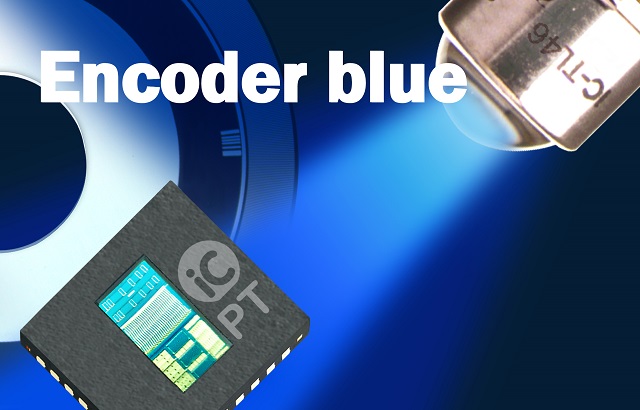 Encoder blue device in space saving optoQFN package
Encoder blue device in space saving optoQFN package
iC-Haus have developed sensor chips for optical position encoders, which contain photodiodes developed specifically for blue light.
The penetration and shorter wavelength of blue-light photons improves the signal amplitude, resolution, jitter performance and harmonic distortion of absolute and incremental encoders. When compared to higher wavelengths, blue light causes less diffraction at the same slot width enabling better and sharper images.
This innovative move toward blue light sources in optical single-chip encoder boost signal quality and allows higher interpolation rate.
The iC-PT H-Series is the first standard single chip encoders family generated by this Encoder blue integration platform.
The latest semiconductor techniques offer shallow, small structures which benefit from the shorter blue light penetration in order to enhance efficiency. Smaller structures also enable an interlaced photodiode layout, which produces cosine and sine encoder signals with lower offset.
In addition, an equivalent geometrical transformation helps to obtain a high fill factor for photosensitive regions. Blue LEDs are the basis for white emitters, which are a highly demanded device in the illumination and automotive markets.
Currently temperature-stable, long term blue LEDs are easily available and surpass red and IR LEDs which are used in encoders, as they offer a better light yield and efficiency at an even lower cost.
Due to technological advancements in LED and CMOS technology, optical position sensors gain a significant advantage. iC-Haus has validated the novel incremental scanners in its high resolution iC-PT H series for blue light.
The trademark Encoder blue signifies the integration platform for this kind of single chip encoders. The iC-PT H-series encoder chips integrate signal interpolation and optimised scanning in the least available space, which is a flat 5x5 mm² optoQFN package having a plane window.
For example, a scanning area of just 1.9 x 3.2 mm is enough to generate 10,000 pulses for each revolution with a code disc of with a diameter of just 26 mm, due to the optimised phased-array opto-chip structure. The theoretical system has better contrast and lower noise with the blue light and consumes less current due to improved efficiency.
The devices emit low-jitter encoder quadrature signals with index, through 4mA push-pull drivers in one, two and four-fold resolution for accurate motor regulation. Also traditional Hall sensors used in the case of motor commutation have been substituted with the combination of three scanning tracks. The specific commutation signal is determined by the code disc and can be tailored easily to go with the needed motor pole count.
The interpolation and index gating are pin-selectable. Up to 1.6 MHz output frequencies are allowed, resulting in motor speed control at up to 10,000 rpm with 10,000 pulses per revolution. It is possible to activate analog test signals for easy alignment and for testing of the complete encoder assembly.
The high sensitivity and small scanning area both help in bringing down the encoder LED’s power requirements. It is enough to have an operating current of a few milliamps.
The LED’s lifetime especially at increased operating temperatures is enhanced. The LED controls the iC-PT H devices and compensates for temperature and aging effects.
iC-Haus offers evaluation boards for scanners along with snap-on blue LEDs and plastic code discs to help in evaluating the advantages of signal quality in directly comparing with IR illumination. During system design, the increased forward voltage of blue LEDs and integrity of the materials utilized in the encoder must be considered.
Encoder blue has now been tested extensively and qualified by renowned encoder manufacturers and is anticipated to be a suitable substitute for modern-day IR LEDs and scanners in existing products to obtain a better resolution.